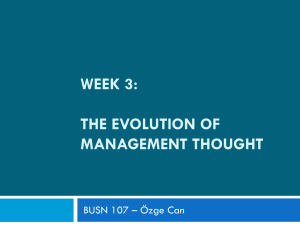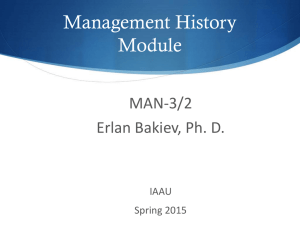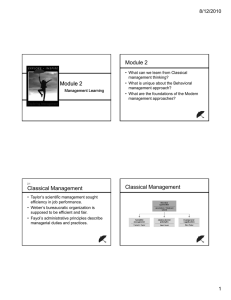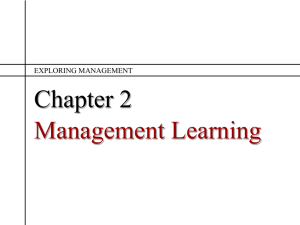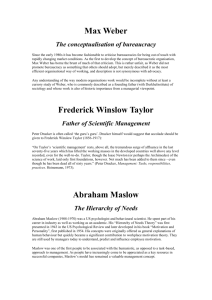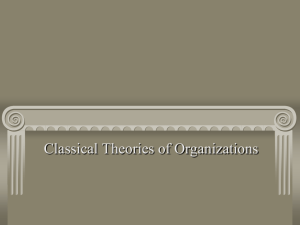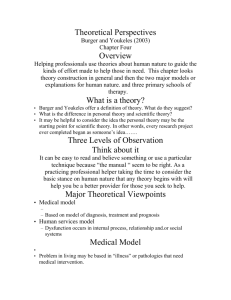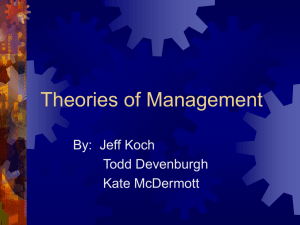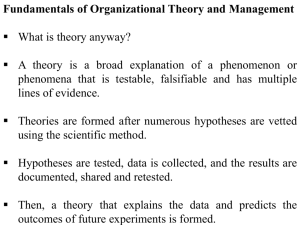theories_of_management_
advertisement
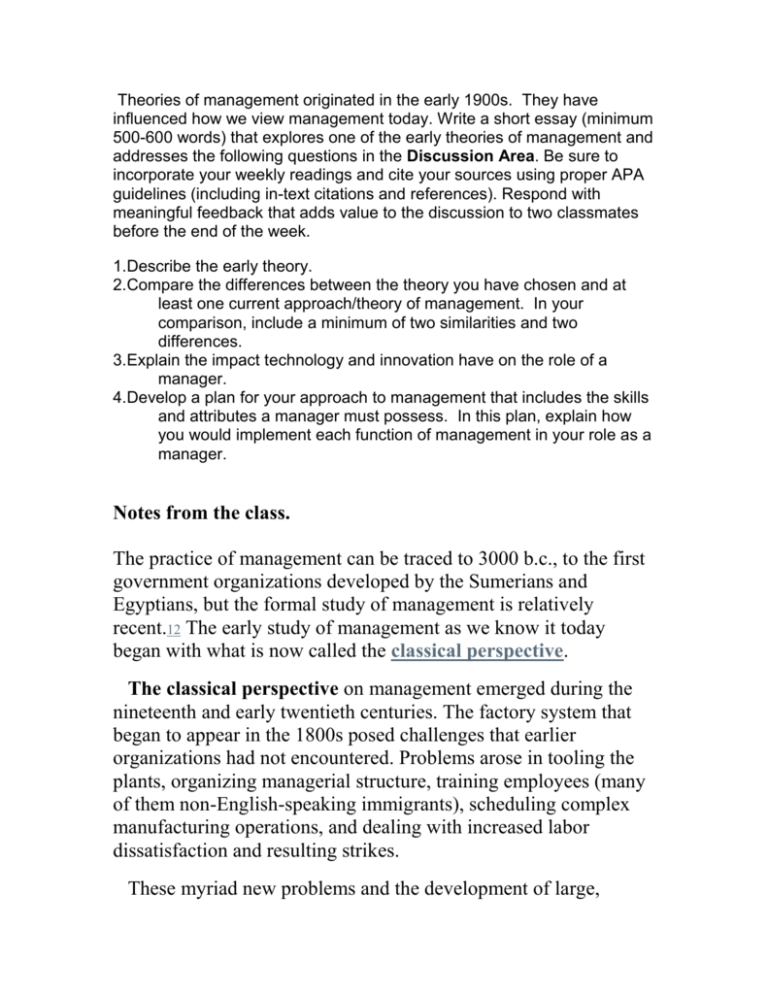
Theories of management originated in the early 1900s. They have influenced how we view management today. Write a short essay (minimum 500-600 words) that explores one of the early theories of management and addresses the following questions in the Discussion Area. Be sure to incorporate your weekly readings and cite your sources using proper APA guidelines (including in-text citations and references). Respond with meaningful feedback that adds value to the discussion to two classmates before the end of the week. 1.Describe the early theory. 2.Compare the differences between the theory you have chosen and at least one current approach/theory of management. In your comparison, include a minimum of two similarities and two differences. 3.Explain the impact technology and innovation have on the role of a manager. 4.Develop a plan for your approach to management that includes the skills and attributes a manager must possess. In this plan, explain how you would implement each function of management in your role as a manager. Notes from the class. The practice of management can be traced to 3000 b.c., to the first government organizations developed by the Sumerians and Egyptians, but the formal study of management is relatively recent.12 The early study of management as we know it today began with what is now called the classical perspective. The classical perspective on management emerged during the nineteenth and early twentieth centuries. The factory system that began to appear in the 1800s posed challenges that earlier organizations had not encountered. Problems arose in tooling the plants, organizing managerial structure, training employees (many of them non-English-speaking immigrants), scheduling complex manufacturing operations, and dealing with increased labor dissatisfaction and resulting strikes. These myriad new problems and the development of large, complex organizations demanded a new approach to coordination and control, and a “new sub-species of economic man—the salaried manager”13—was born. Between 1880 and 1920, the number of professional managers in the United States grew from 161,000 to more than 1 million.14 These professional managers began developing and testing solutions to the mounting challenges of organizing, coordinating, and controlling large numbers of people and increasing worker productivity. Thus began the evolution of modern management with the classical perspective. This perspective contains three subfields, each with a slightly different emphasis: scientific management, bureaucratic organizations, and administrative principles. cientific management emphasizes scientifically determined jobs and management practices as the way to improve efficiency and labor productivity. In the late 1800s, a young engineer, Frederick Winslow Taylor (1856–1915), proposed that workers “could be retooled like machines, their physical and mental gears recalibrated for better productivity.”16 Taylor insisted that improving productivity meant that management itself would have to change and, further, that the manner of change could be determined only by scientific study; hence, the label scientific management emerged. Taylor suggested that decisions based on rules of thumb and tradition be replaced with precise procedures developed after careful study of individual situations.17 The scientific management approach is illustrated by the unloading of iron from rail cars and reloading finished steel for the Bethlehem Steel plant in 1898. Taylor calculated that with the correct movements, tools, and sequencing, each man was capable of loading 47.5 tons per day instead of the typical 12.5 tons. He also worked out an incentive system that paid each man $1.85 a day for meeting the new standard, an increase from the previous rate of $1.15. Productivity at Bethlehem Steel shot up overnight. Auto maker Henry Ford made extensive use of Frederick Taylor's scientific management techniques, as illustrated by this assembly of an automobile at a Ford plant circa 1930. Ford replaced workers with machines for heavy lifting and moving autos from one worker to the next This reduced worker hours and improved efficiency and productivity. Under this system, a Ford car rolled off the assembly line every 10 seconds. A systematic approach developed in Europe that looked at the organization as a whole is the bureaucratic organizations approach, a subfield within the classical perspective. Max Weber (1864–1920), a German theorist, introduced most of the concepts on bureaucratic organizations.21 During the late 1800s, many European organizations were managed on a personal, family like basis. Employees were loyal to a single individual rather than to the organization or its mission. The dysfunctional consequence of this management practice was that resources were used to realize individual desires rather than organizational goals. Employees in effect owned the organization and used resources for their own gain rather than to serve customers. Weber envisioned organizations that would be managed on an impersonal, rational basis. This form of organization was called a bureaucracy. Exhibit 2-3 summarizes the six characteristics of bureaucracy as specified by Weber. “Students would be more likely to have a positive impact on the future of management if they were more engaged with the history and traditions of management—particularly that of a German sociologist [Weber] who died nearly 100 years ago.” —STEPHEN CUMMINGS AND TODD BRIDGMAN, VICTORIA UNIVERSITY OF WELLINGTON, NEW ZEALAND Another major subfield within the classical perspective is known as the administrative principles approach. Whereas scientific management focused on the productivity of the individual worker, the administrative principles approach focused on the total organization. The major contributor to this approach was Henri Fayol (1841–1925), a French mining engineer who worked his way up to become head of a large mining group known as Comambault. Pieces of Comambault survive today as part of ArcelorMittal, the world's largest steel and mining company. In his later years, Fayol wrote down his concepts on administration, based largely on his own management experiences.25 In his most significant work, General and Industrial Management, Fayol discussed 14 general principles of management, several of which are part of management philosophy today. For example: 5. • Unity of command. Each subordinate receives orders from one—and only one— superior. 6. • Division of work. Managerial work and technical work are amenable to specialization to produce more and better work with the same amount of effort. 7. • Unity of direction. Similar activities in an organization should be grouped together under one manager. • Scalar chain. A chain of authority extends from the top to the bottom of the organization and should include every employee. The humanistic perspective on management emphasized the importance of understanding human behaviors, needs, and attitudes in the workplace, as well as social interactions and group processes. There are three primary subfields based on the humanistic perspective: the human relations movement, the human resources perspective, and the behavioral sciences approach. Two early advocates of a more humanistic approach were Mary Parker Follett and Chester Barnard. Mary Parker Follett (1868– 1933) was trained in philosophy and political science, but she applied herself in many fields, including social psychology and management. She wrote of the importance of common superordinate goals for reducing conflict in organizations.27 Her work was popular with businesspeople of her day but was often overlooked by management scholars.28 Follett's ideas served as a contrast to scientific management and are re-emerging as applicable for modern managers dealing with rapid changes in today's global environment. Her approach to leadership stressed the importance of people rather than engineering techniques. She offered the pithy admonition, “Don't hug your blueprints,” and analyzed the dynamics of management-organization interactions. Follett addressed issues that are timely today, such as ethics, power, and leading in a way that encourages employees to give their best. The concepts of empowerment, facilitating rather than controlling employees, and allowing employees to act depending on the authority of the situation opened new areas for theoretical study by Chester Barnard and others.29 The human relations movement initially espoused a dairy farm view of management— just as contented cows give more milk, satisfied workers will produce more work. Gradually, views with deeper content began to emerge. The human resources perspective maintained an interest in worker participation and considerate leadership but shifted the emphasis to consider the daily tasks that people perform. The human resources perspective combines prescriptions for design of job tasks with theories of motivation.39 In the human resources view, jobs should be designed so that tasks are not perceived as dehumanizing or demeaning but instead allow workers to use their full potential. Two of the best-known contributors to the human resources perspective were Abraham Maslow and Douglas McGregor. Abraham Maslow (1908–1970), a practicing psychologist, observed that his patients' problems usually stemmed from an inability to satisfy their needs. Thus, he generalized his work and suggested a hierarchy of needs. Maslow's hierarchy started with physiological needs and progressed to safety, belongingness, esteem, and, finally, self-actualization needs. The point of Theory Y is that organizations can take advantage of the imagination and intellect of all their employees. Employees will exercise self-control and will contribute to organizational goals when given the opportunity. A few companies today still use Theory X management, but many are using Theory Y techniques. Consider how Semco applies Theory Y assumptions to tap into employee creativity and mind power. The behavioral sciences approach uses scientific methods and draws from sociology, psychology, anthropology, economics, and other disciplines to develop theories about human behavior and interaction in an organizational setting. This approach can be seen in practically every organization. When a company such as Zappos.com conducts research to determine the best set of tests, interviews, and employee profiles to use when selecting new employees, it is using behavioral science techniques. When Best Buy electronics stores train new managers in the techniques of employee motivation, most of the theories and findings are rooted in behavioral science research. One specific set of management techniques based in the behavioral sciences approach is organization development (OD). In the 1970s, OD evolved as a separate field that applied the behavioral sciences to improve the organization's health and effectiveness through its ability to cope with change, improve internal relationships, and increase problem-solving capabilities.42 The techniques and concepts of OD have since been broadened and expanded to address the increasing complexity of organizations and the environment, and OD is still a vital approach for managers. OD will be discussed in detail in Chapter 11. Other concepts that grew out of the behavioral sciences approach include matrix organizations, self-managed teams, ideas about corporate culture, and management by wandering around. Indeed, the behavioral sciences approach has influenced the majority of tools, techniques, and approaches that managers have applied to organizations since the 1970s.
